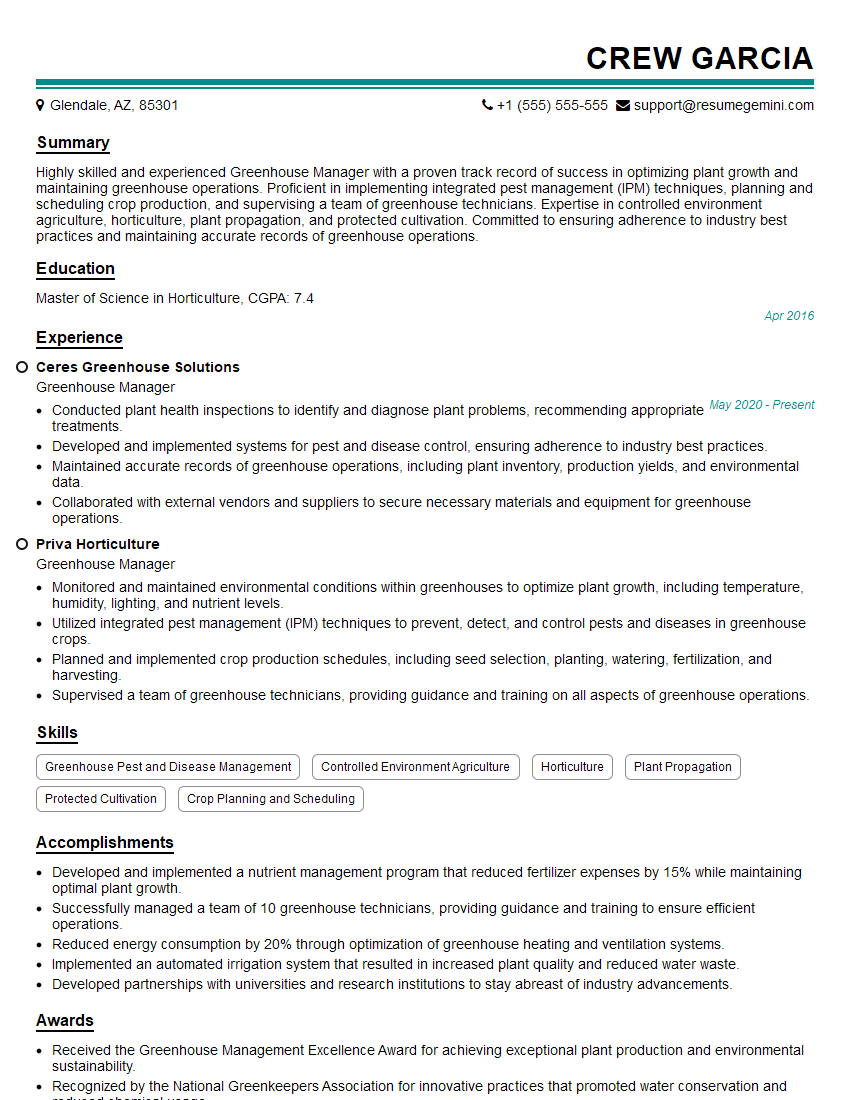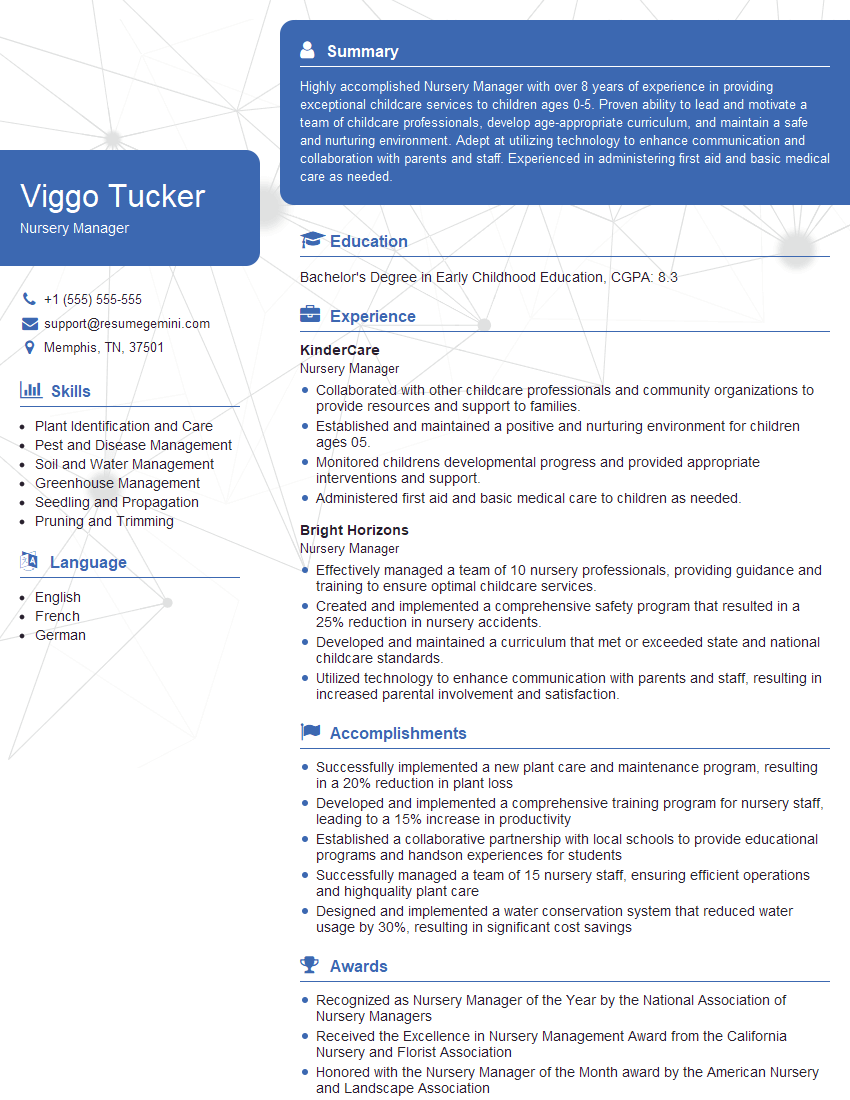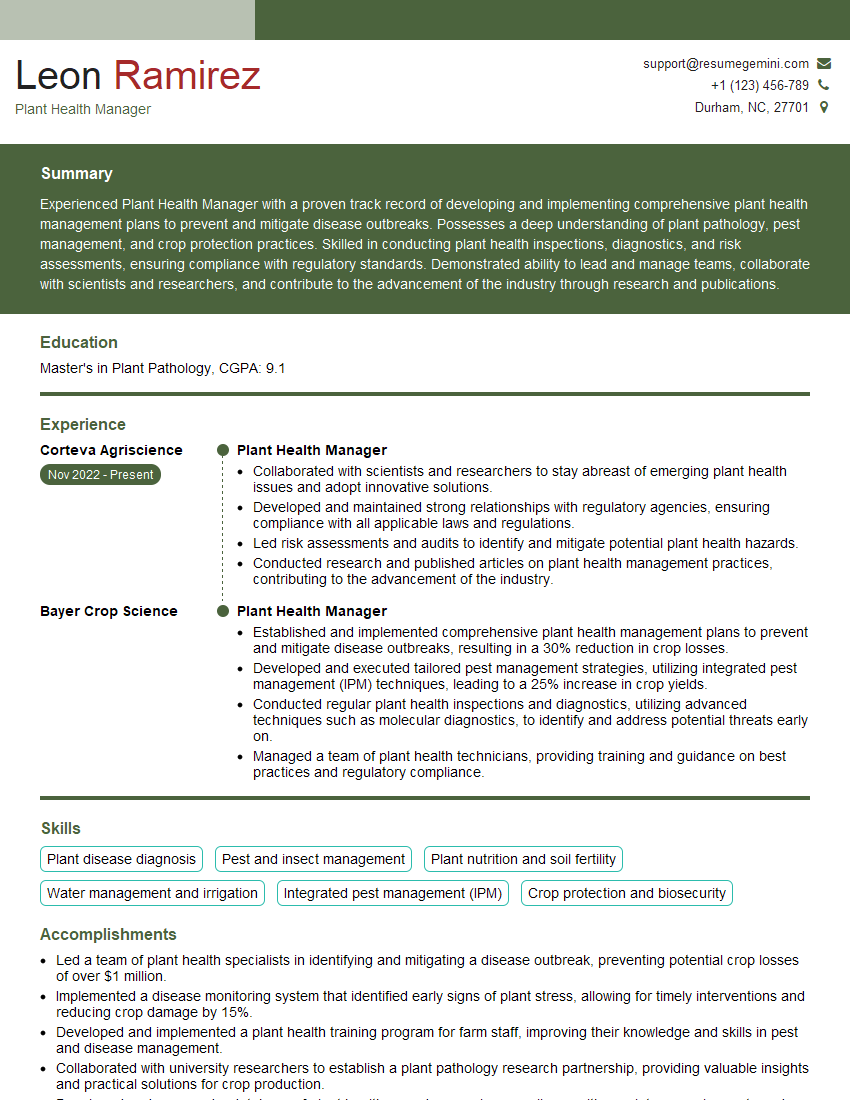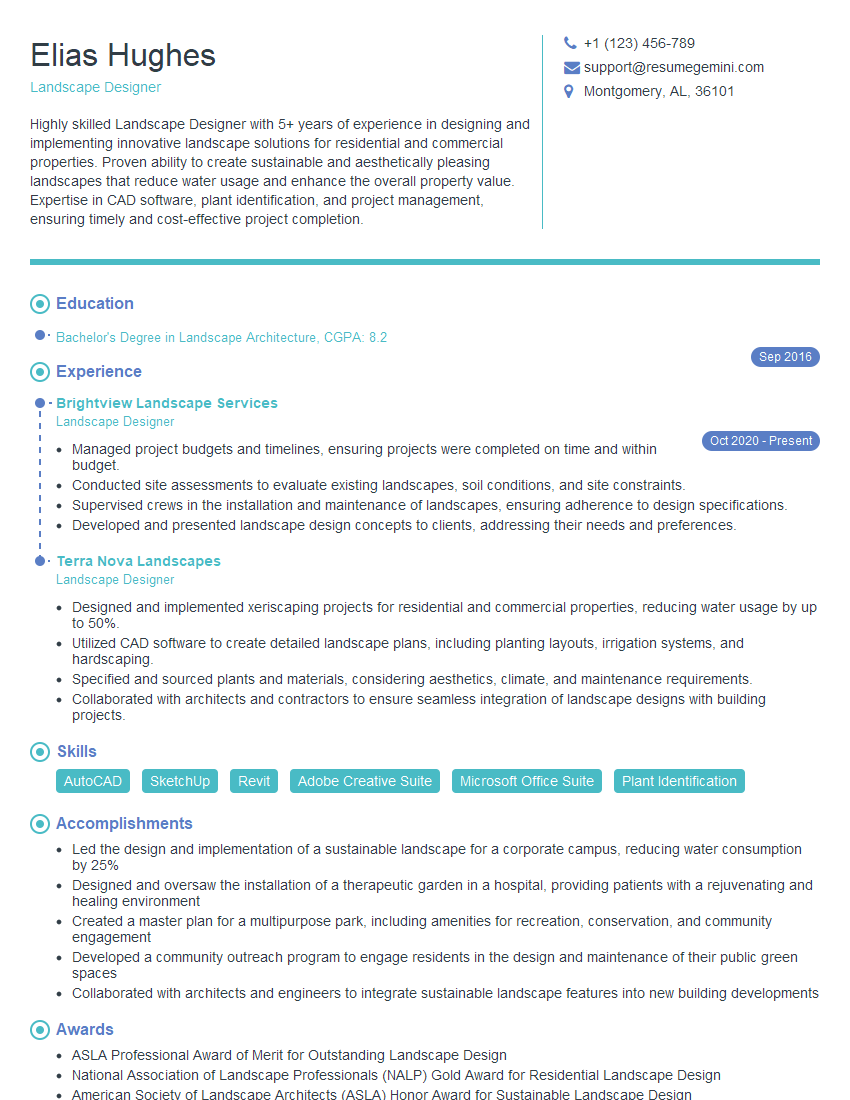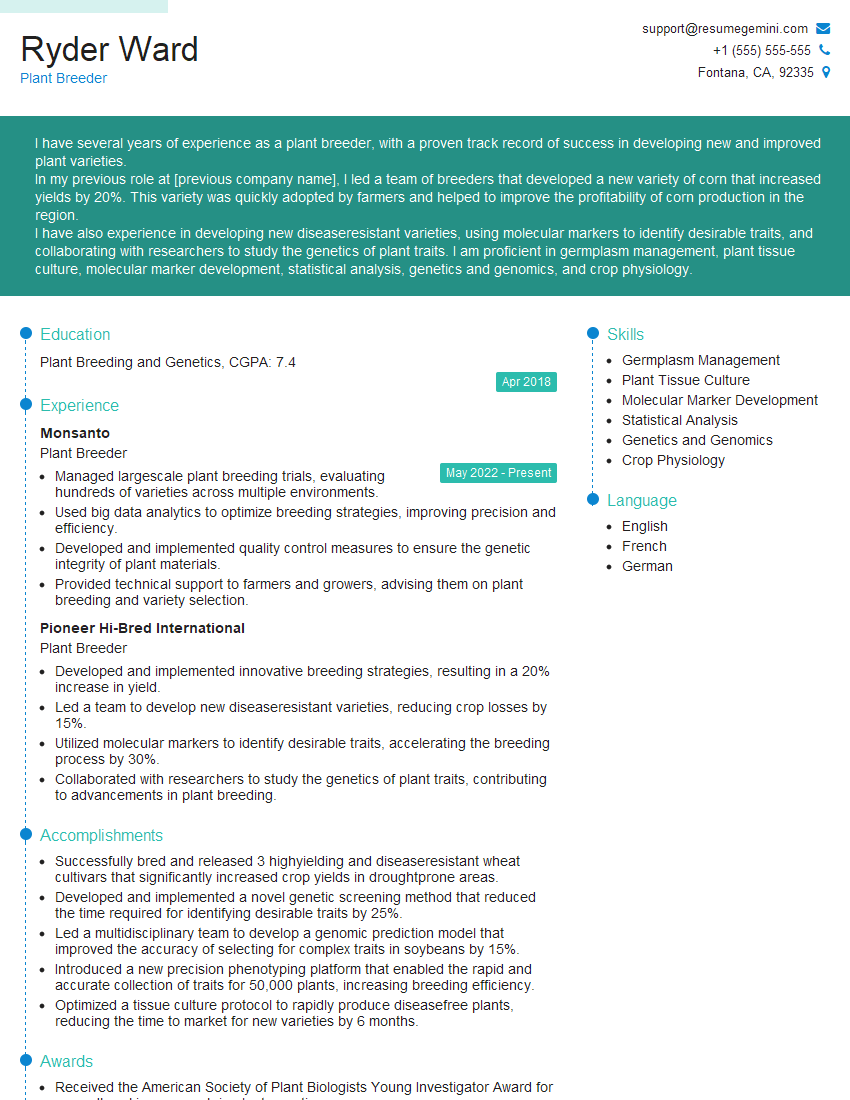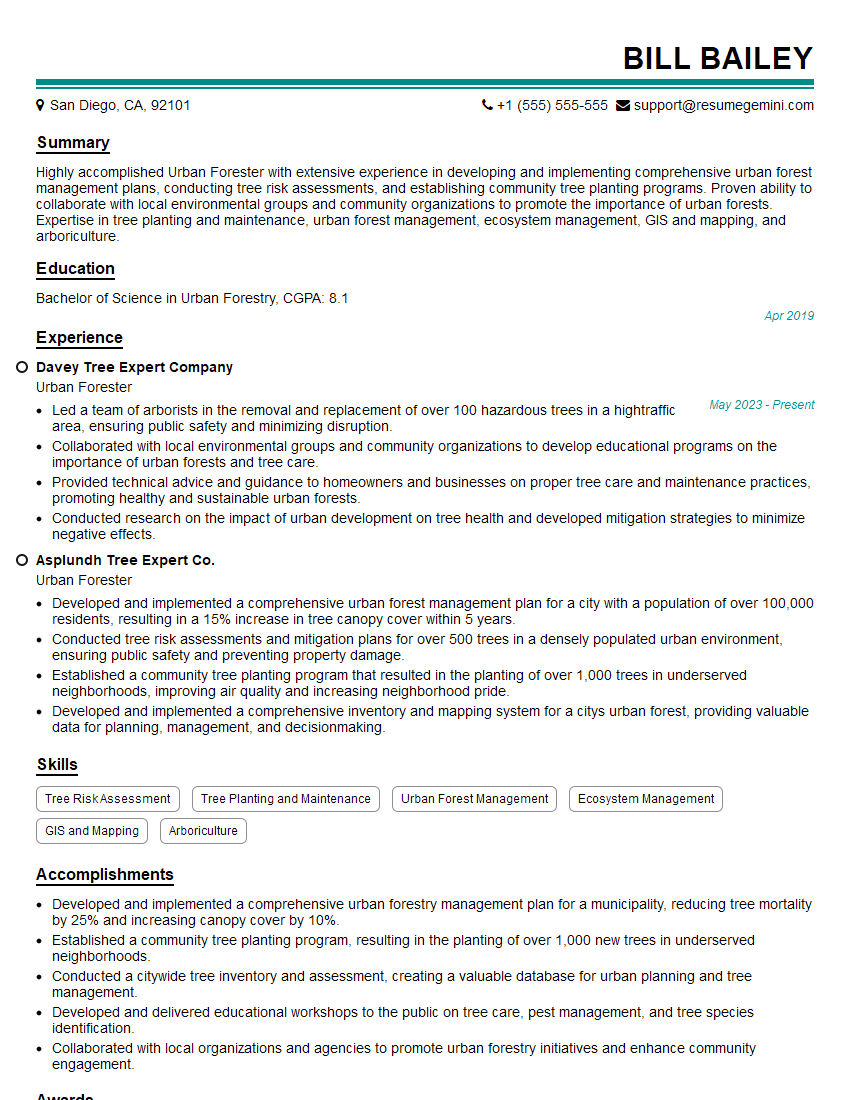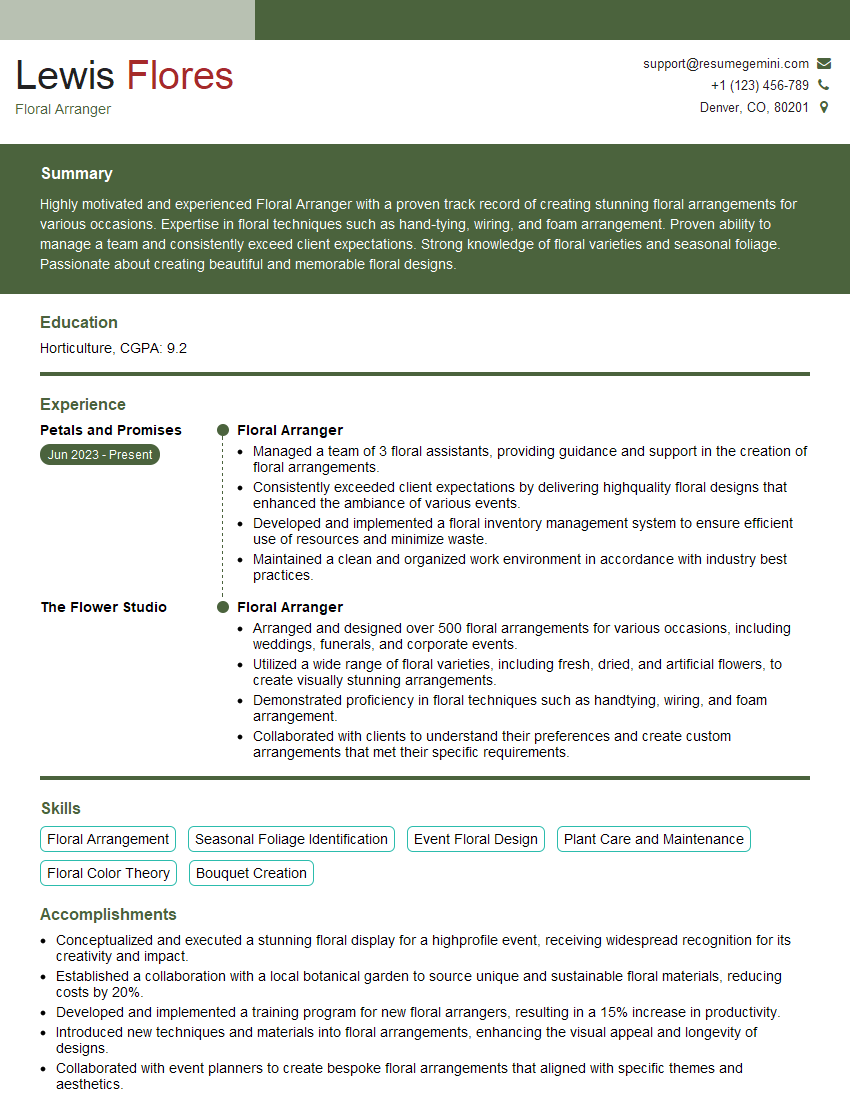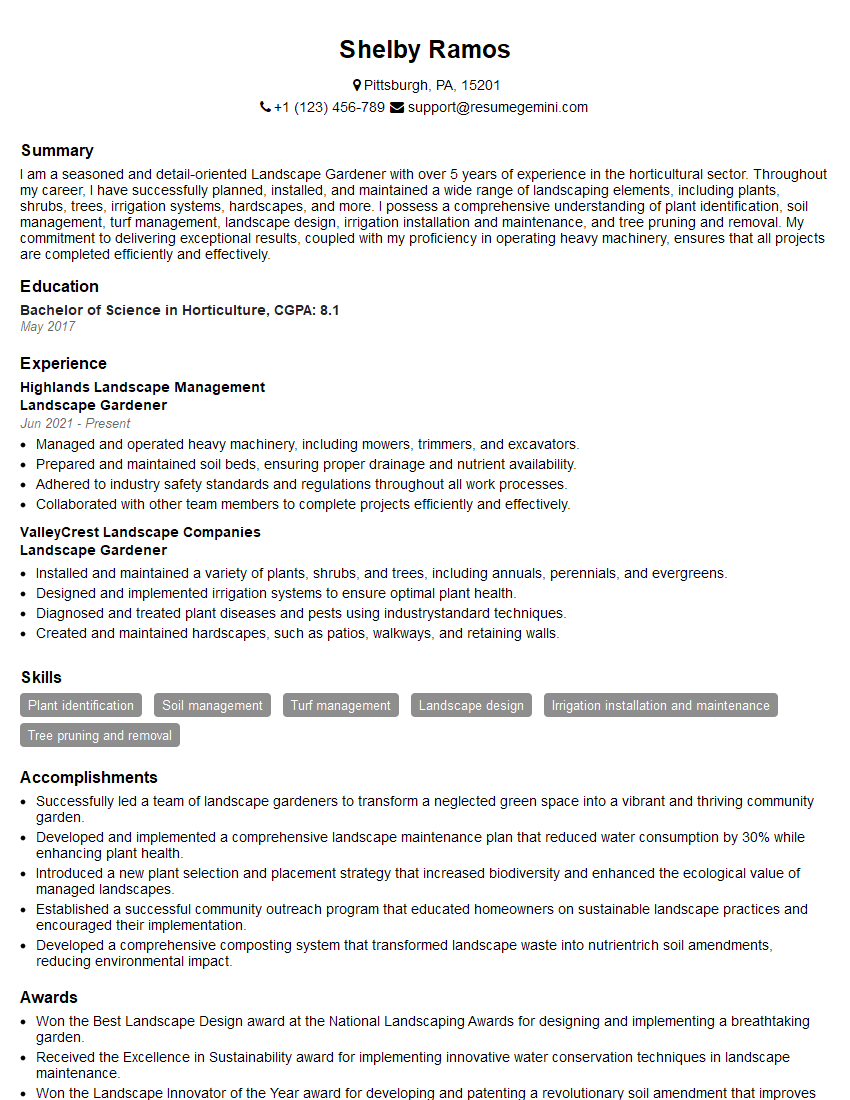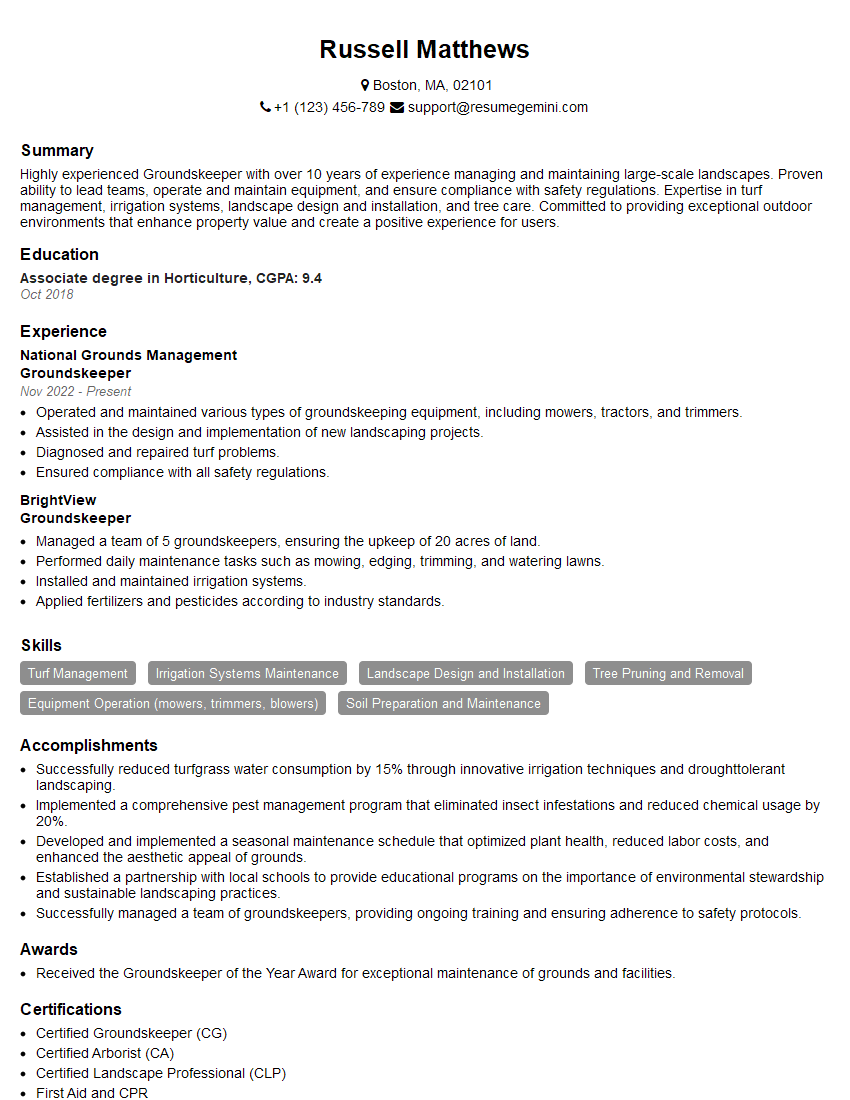The thought of an interview can be nerve-wracking, but the right preparation can make all the difference. Explore this comprehensive guide to Ornamental Plant Care interview questions and gain the confidence you need to showcase your abilities and secure the role.
Questions Asked in Ornamental Plant Care Interview
Q 1. Explain the process of plant propagation through cuttings.
Plant propagation through cuttings is a vegetative method of asexual reproduction, where a new plant is grown from a piece of the parent plant. It’s a popular technique because it allows for the rapid multiplication of desirable plant varieties, preserving their exact genetic characteristics.
The process generally involves these steps:
- Selecting the cutting: Choose healthy, actively growing stems or leaves. The ideal time is often during the growing season when the plant is most vigorous. Consider the type of cutting: softwood cuttings (new growth), semi-hardwood cuttings (slightly mature growth), or hardwood cuttings (mature, dormant growth). Different plants respond better to different types of cuttings.
- Preparing the cutting: Cut the stem at a 45-degree angle just below a node (where leaves or branches emerge). Remove lower leaves that would be submerged in the rooting medium to prevent rot. For some plants, a rooting hormone can be applied to the cut end to stimulate root growth.
- Planting the cutting: Plant the cutting in a suitable rooting medium, such as a well-draining mixture of peat moss and perlite. Ensure that the cutting is firmly planted, but not too deep.
- Providing optimal conditions: Maintain high humidity (e.g., using a humidity dome or misting regularly) and consistent moisture. Bright, indirect sunlight is usually ideal. Avoid direct sun, which can quickly dehydrate the cutting.
- Root development and transplanting: Root development can take several weeks or even months, depending on the plant species. Once roots are established (you can gently tug on the cutting – if it resists, it likely has roots), transplant into individual pots with appropriate potting mix.
Example: Propagating a coleus plant is relatively easy using softwood cuttings. They root readily and quickly.
Q 2. Describe common diseases affecting roses and their treatment.
Roses are susceptible to various diseases, many of which are fungal or bacterial in nature. Early detection and appropriate treatment are crucial for preventing significant damage.
- Black Spot: Characterized by black spots on leaves, leading to defoliation. Treatment involves removing infected leaves, applying fungicides (following label instructions), and ensuring good air circulation around the plant.
- Powdery Mildew: A white, powdery coating on leaves and stems. Good air circulation and the application of fungicides (specifically those targeting powdery mildew) are effective management strategies. Avoid overhead watering, as this encourages the spread of the disease.
- Rose Rust: Orange pustules on the undersides of leaves, causing yellowing and premature leaf drop. Fungicide application and removal of infected leaves are necessary.
- Downy Mildew: Similar to powdery mildew but often with purplish spots on the undersides of leaves. Control involves fungicide application and improved air circulation.
Important Note: Always identify the specific disease before applying treatment. Consult a local nursery or agricultural extension office for accurate diagnosis and recommendations. Integrated Pest Management (IPM) strategies, which incorporate non-chemical controls like sanitation and cultural practices, are often the best approach.
Q 3. What are the key factors to consider when selecting plants for a specific climate?
Selecting plants for a specific climate is essential for their survival and thriving. Key factors to consider include:
- Hardiness Zones: These zones represent geographic areas with similar average minimum winter temperatures. Choose plants that are rated for your specific hardiness zone to avoid winter damage. (USDA Plant Hardiness Zone Map is a valuable resource).
- Sunlight Exposure: Determine the amount of sunlight your planting location receives (full sun, partial shade, full shade). Match plants to their light requirements to ensure healthy growth.
- Rainfall and Water Availability: Consider your local rainfall patterns and water restrictions. Drought-tolerant plants are ideal for arid regions, while moisture-loving plants thrive in consistently moist conditions.
- Soil Type: Different plants have different soil preferences (e.g., sandy, clay, loamy). Knowing your soil type helps you select plants that will grow well in those conditions. Soil testing can help determine pH and nutrient levels.
- Average Temperatures: Beyond winter hardiness, consider average summer temperatures. Some plants will struggle in extreme heat, while others need specific chilling hours to flower properly.
Example: If you live in a region with hot, dry summers and mild winters, choosing drought-tolerant plants like lavender or succulents is crucial. In a cooler, wetter climate, you might opt for plants that thrive in damp conditions, such as hostas or ferns.
Q 4. How do you identify and manage common pests in ornamental plants?
Pest identification and management is a continuous process in ornamental plant care. Accurate identification is the first step in effective control.
- Visual Inspection: Regularly inspect plants for signs of pests, such as insects, mites, or snails. Look for damage to leaves, stems, flowers, or roots.
- Pest Identification Resources: Use field guides, online resources (e.g., university extension websites), or consult with experts to identify specific pests.
- Integrated Pest Management (IPM): This holistic approach prioritizes non-chemical methods first. Techniques include:
- Cultural control: Proper planting, watering, and fertilization practices to create a less favorable environment for pests.
- Mechanical control: Handpicking insects, using traps, or physically removing weeds that harbor pests.
- Biological control: Introducing beneficial insects (e.g., ladybugs for aphids) or using microbial pesticides.
- Chemical Control (as a last resort): Use insecticides or miticides only when other methods fail, and always follow label instructions carefully. Consider the impact on non-target organisms and the environment.
Example: Aphids are common pests. You can try washing them off with a strong stream of water, introduce ladybugs, or use an insecticidal soap only if necessary. Always wear appropriate protective gear when handling pesticides.
Q 5. Explain the importance of proper soil drainage for plant health.
Proper soil drainage is critical for plant health because it prevents waterlogging, which can lead to root rot and other diseases. Waterlogged soil lacks oxygen, suffocating plant roots and preventing them from absorbing nutrients effectively.
Well-drained soil allows excess water to percolate away, preventing root damage. The ideal soil has a balance of air and water, ensuring both root respiration and nutrient uptake. Poorly drained soil can lead to various problems:
- Root Rot: The most significant consequence, as the plant’s roots are unable to function properly.
- Nutrient Deficiencies: Waterlogged soil can hinder nutrient absorption, leading to yellowing leaves, stunted growth, and reduced flowering.
- Increased susceptibility to pests and diseases: Waterlogged conditions create an environment favorable to many plant pathogens.
Improving soil drainage involves adding organic matter (e.g., compost), amending heavy clay soils with sand or perlite, ensuring proper grading to facilitate water runoff, and potentially installing drainage systems in severely waterlogged areas.
Q 6. Describe different irrigation techniques for ornamental plants.
Irrigation techniques for ornamental plants vary depending on the plant’s needs, the climate, and available resources. The goal is to provide adequate water without overwatering or underwatering.
- Drip Irrigation: Delivers water directly to the plant’s root zone through a network of tubes and emitters, minimizing water loss through evaporation and runoff. Ideal for individual plants or rows of plants.
- Soaker Hoses: Similar to drip irrigation but with a more porous tubing, allowing water to seep into the soil along its length. Suitable for beds or borders.
- Overhead Sprinklers: While efficient for larger areas, overhead watering can lead to leaf diseases, especially in humid conditions. Avoid overhead watering during the hottest parts of the day.
- Hand Watering: Provides targeted watering, particularly beneficial for container plants or plants with specific water requirements. Avoid overwatering.
- Sub-Irrigation: Water is applied below the soil surface, allowing the plant’s roots to draw water upwards. This reduces water loss and minimizes the potential for disease.
The chosen method should account for water conservation, the plant’s water needs, and the size and layout of the planting area. A well-designed irrigation system is a key component of successful ornamental plant care.
Q 7. What are the benefits and drawbacks of using chemical fertilizers versus organic fertilizers?
Both chemical and organic fertilizers provide essential nutrients for plant growth, but they differ significantly in their composition, application, and environmental impact.
Chemical Fertilizers (Synthetic):
- Benefits: Provide readily available nutrients in specific ratios, leading to rapid growth. Easy to apply and measure.
- Drawbacks: Can burn plants if applied improperly, potentially leading to nutrient imbalances. Can contribute to water pollution through runoff. May not improve soil structure or microbial activity in the long term. Often lack micronutrients essential for optimal plant health.
Organic Fertilizers (Natural):
- Benefits: Improve soil structure and microbial activity over time, leading to healthier soil and more sustainable plant growth. Less likely to burn plants. Environmentally friendly.
- Drawbacks: Nutrients are released more slowly, resulting in less rapid growth. Can be more expensive than chemical fertilizers. Composition can be less consistent.
The Best Approach: An integrated approach often works best. Using organic fertilizers for soil improvement and supplementing with targeted chemical fertilizers when needed, such as when deficiencies are identified through soil testing, can offer the benefits of both. Always choose fertilizers appropriate for the specific plant and the growing conditions.
Q 8. How do you prune different types of shrubs and trees?
Pruning shrubs and trees is crucial for maintaining their shape, health, and vigor. The approach varies greatly depending on the species, its growth habit, and your goals (e.g., shaping, rejuvenating, or removing dead wood).
- Heading Back: This involves cutting back stems to a point where new growth will emerge. It’s great for encouraging bushier growth in many shrubs like hydrangeas or foriynthia. Think of it like giving the plant a ‘haircut’.
- Thinning: This involves removing entire branches, usually back to their point of origin. This improves air circulation and light penetration, reducing the risk of disease. It’s particularly beneficial for trees like crape myrtles and deciduous trees to maintain an open canopy. Think of it like thinning out a crowded forest.
- Shearing: This involves using shears to create a precise, formal shape. It’s commonly used for hedges and topiary. Think of it like giving a hedge a really neat trim.
Examples: A crape myrtle benefits from thinning in late winter to remove dead or crossing branches, while a formal boxwood hedge requires regular shearing throughout the growing season. Always use sharp, clean tools to prevent the spread of disease.
Q 9. Explain the principles of plant nutrition and fertilization.
Plant nutrition is all about providing the essential elements plants need to thrive – a bit like providing a balanced diet for humans!
These elements are broadly classified as macronutrients (needed in larger quantities) and micronutrients (needed in smaller amounts). Macronutrients include nitrogen (N), phosphorus (P), and potassium (K), which are often represented as NPK on fertilizer labels. Nitrogen promotes leafy growth, phosphorus aids root development and flowering, and potassium enhances overall plant health and disease resistance.
Fertilization involves supplementing the soil with these essential nutrients. The best approach depends on the plant’s needs, soil type, and existing nutrient levels. Soil testing is crucial to determine the precise nutrient deficiencies and avoid over-fertilization, which can harm plants.
Examples: A nitrogen-rich fertilizer might be used to encourage lush growth in lawn grasses, while a balanced NPK fertilizer is suitable for many flowering plants and shrubs. Over-fertilizing with nitrogen can lead to weak, leggy growth and susceptibility to pests and diseases, whereas over-fertilizing with phosphorus can harm roots.
Q 10. Describe the process of diagnosing plant diseases.
Diagnosing plant diseases requires a systematic approach. Think of it like being a plant detective!
Step 1: Observe carefully. Note the symptoms: Are leaves spotted, yellowing, wilting, or showing unusual growth? Are stems or branches affected? Take photos to document the progression of the problem.
Step 2: Consider the environment. What are the soil conditions like? Is the plant receiving adequate sunlight and water? Is there evidence of pests? Environmental factors often play a crucial role in disease development.
Step 3: Identify the pathogen. This can be challenging and may require laboratory testing, but you can often narrow down the possibilities by using reliable plant disease guides or consulting with a plant pathologist. It’s essential to differentiate between fungal, bacterial, viral, or other causes.
Step 4: Implement appropriate control measures. Treatment options depend on the identified disease. They range from cultural practices (improving drainage, pruning affected parts) to chemical controls (applying fungicides or bactericides) – always following label instructions carefully. Prevention is always best, focusing on maintaining good plant health and sanitation.
Q 11. What are the best practices for winterizing outdoor ornamental plants?
Winterizing ornamental plants protects them from harsh winter conditions. This process ensures survival and protects against damage during the dormant season.
- Mulching: Applying a layer of mulch (2-4 inches) around the base of plants insulates their roots, protecting them from freezing temperatures and preventing soil erosion.
- Watering: Thorough watering before the ground freezes helps plants store moisture. This is particularly crucial for evergreen plants.
- Protection from wind and sun: Windbreaks (e.g., burlap screens) can shield plants from harsh winds, while winter sun can cause damage to evergreens. Consider using shade cloth or other suitable protection for vulnerable plants.
- Pruning (if needed): Some pruning might be necessary in late fall to remove dead or damaged branches, minimizing wind damage and disease risk. However, avoid extensive pruning in winter.
- Protecting sensitive plants: Tender plants may require additional protection, such as wrapping them in burlap or moving them indoors to a sheltered location.
Examples: Rose bushes benefit from a heavy mulch and covering with burlap; evergreens can be protected with burlap wind screens or anti-desiccant sprays; container plants should be moved to a protected area or insulated.
Q 12. How do you select appropriate mulch for different plant types?
Mulch selection is vital for maintaining soil health and plant well-being. The best choice depends on factors such as the plant type, climate, and aesthetic preferences.
- Organic Mulches: These decompose over time, enriching the soil with organic matter. Examples include wood chips, shredded bark, straw, and compost. They are ideal for many plants, including trees and shrubs, as they improve soil structure and moisture retention.
- Inorganic Mulches: These are more durable and don’t decompose. Examples include gravel, stone, and landscape fabric. They are often used in drier climates or areas where weed suppression is a primary concern. However, they don’t enhance soil fertility like organic mulches.
Examples: Wood chips are excellent for trees and shrubs, providing good moisture retention and weed suppression. Gravel is a suitable choice for drought-tolerant plants in hot, sunny locations, while shredded bark gives a neater look for flower beds.
Important Consideration: Avoid using mulch too close to the plant stems, as this can encourage fungal diseases. Keep a small gap for good air circulation.
Q 13. Explain the importance of light, temperature, and humidity in plant growth.
Light, temperature, and humidity are fundamental environmental factors influencing plant growth. Think of them as the plant’s basic needs – like food, water, and shelter for humans.
- Light: Plants require sunlight for photosynthesis, the process by which they convert light energy into chemical energy for growth. Different plants have different light requirements: Some thrive in full sun, others prefer partial shade or shade. Insufficient light leads to weak growth and etiolation (leggy growth).
- Temperature: Plants have optimal temperature ranges for growth. Extreme temperatures (too hot or too cold) can damage or kill plants. Freezing temperatures can cause tissue damage or death, while excessively high temperatures can lead to stress and wilting.
- Humidity: The level of moisture in the air affects transpiration (water loss from plants). High humidity can increase the risk of fungal diseases, while low humidity can lead to desiccation, especially in dry climates.
Examples: Sunflowers need at least six hours of direct sunlight, whereas hostas thrive in shady areas. Tropical plants require high humidity, while desert plants are adapted to low humidity conditions. Understanding these requirements is crucial for selecting appropriate plants for a specific location.
Q 14. How do you manage weeds effectively in a landscape setting?
Weed management is essential for maintaining a healthy landscape. An integrated approach, combining several strategies, is most effective.
- Cultural Practices: These focus on preventing weed growth. They include proper soil preparation (removing existing weeds before planting), mulching to suppress weed germination, and planting densely to compete with weeds.
- Mechanical Control: This involves physically removing weeds. Methods include hand-weeding, hoeing, and cultivating. This is particularly effective for small areas or specific weeds.
- Chemical Control: Herbicides can be used to control weeds, but they should be applied cautiously and selectively to minimize damage to desirable plants. Always read and follow label instructions carefully.
- Biological Control: This involves using natural enemies to control weeds. Examples include introducing beneficial insects or using cover crops to outcompete weeds. This approach is environmentally friendly but may not be suitable for all weed problems.
Examples: Mulching effectively suppresses many weeds, hand-weeding is ideal for small gardens, and selective herbicides are useful for controlling specific weeds in larger areas. Using a combination of these methods gives best results and prevents weed dominance.
Q 15. Describe your experience with hydroponic or other soilless growing systems.
My experience with hydroponic and soilless systems is extensive. I’ve worked with various setups, from simple wicking systems for smaller-scale operations to sophisticated recirculating deep water culture (RDWC) systems for larger commercial projects. Hydroponics offers precise control over nutrient delivery, leading to faster growth and higher yields compared to soil-based cultivation. I’ve successfully cultivated a wide range of ornamental plants using these methods, including orchids, leafy greens for bedding, and even flowering vines. For example, with orchids, the precise control of moisture and nutrient levels significantly reduces the risk of root rot, a common problem in traditional potting. In RDWC systems, the consistent aeration and nutrient supply promote robust root development resulting in healthier and more vibrant plants. However, it’s crucial to maintain precise nutrient balances and monitor pH levels meticulously, as imbalances can quickly harm the plants. Understanding the specific nutrient requirements of each plant species is paramount for success in soilless systems.
Career Expert Tips:
- Ace those interviews! Prepare effectively by reviewing the Top 50 Most Common Interview Questions on ResumeGemini.
- Navigate your job search with confidence! Explore a wide range of Career Tips on ResumeGemini. Learn about common challenges and recommendations to overcome them.
- Craft the perfect resume! Master the Art of Resume Writing with ResumeGemini’s guide. Showcase your unique qualifications and achievements effectively.
- Don’t miss out on holiday savings! Build your dream resume with ResumeGemini’s ATS optimized templates.
Q 16. How do you create a successful planting design for a specific area?
Creating a successful planting design involves a multifaceted approach. First, I thoroughly assess the site’s conditions: sunlight exposure, soil type, existing drainage, and microclimate (e.g., wind exposure, shade patterns). Next, I consider the client’s preferences, budget, and intended use of the space. Then, I select plants based on their size, shape, color, texture, and bloom time, ensuring a visually appealing and balanced composition. I incorporate principles of plant diversity to support a healthy ecosystem and minimize pest and disease risks. For example, a border design might combine tall, upright plants with cascading or groundcover species, creating visual interest and depth. I always account for mature plant sizes to prevent overcrowding, and I integrate plants with varying water needs strategically to optimize irrigation management. Finally, I prepare detailed planting plans with plant locations, species, and quantities, ensuring seamless installation and long-term success.
Q 17. What are the different types of grafting techniques and when are they used?
Several grafting techniques exist, each suited for specific plant species and purposes.
- Whip and Tongue Grafting: This involves making angled cuts on both the scion (desired plant) and rootstock (base plant), creating interlocking tongues that enhance union. It’s commonly used for fruit trees and roses.
- Cleft Grafting: A vertical split is made in the rootstock, and the scion wedge is inserted. Simple and effective for larger rootstocks.
- Bud Grafting (T-budding): A T-shaped incision is made in the rootstock bark, and a bud from the scion is inserted. Efficient and widely used for propagating numerous plants.
- Approach Grafting: Scion and rootstock are grown separately until they touch, then grafted together. Used for difficult-to-graft species.
Q 18. Explain the importance of soil testing in horticultural practices.
Soil testing is fundamental to successful horticultural practices because it provides crucial information about the soil’s composition and nutrient levels. This information allows for informed decisions regarding fertilization, amendment additions, and overall plant health management. A soil test identifies deficiencies (e.g., nitrogen, phosphorus, potassium) and toxicities (e.g., high salinity). For instance, a soil test may reveal a deficiency in phosphorus, which is vital for root development and flowering. Based on the test results, we can amend the soil with phosphorus-rich fertilizers to correct this deficiency and promote healthy plant growth. Furthermore, a soil test determines the soil’s pH, which impacts nutrient availability. Adjusting the pH through the addition of lime (to increase pH) or sulfur (to decrease pH) ensures that plants can efficiently absorb essential nutrients. Ignoring soil testing leads to suboptimal plant growth, reduced yields, and potential plant health problems.
Q 19. Describe your experience with using different types of pesticides and herbicides.
My experience with pesticides and herbicides involves a strong emphasis on integrated pest management (IPM). This approach prioritizes prevention and non-chemical control methods before resorting to chemical applications. I’m familiar with various pesticide types, including insecticides (targeting insects), fungicides (for fungal diseases), and miticides (for mites). Herbicides are used sparingly, focusing on selective herbicides that target specific weeds while minimizing harm to desirable plants. I meticulously follow label instructions and safety protocols for all chemical applications, wearing appropriate personal protective equipment (PPE). For example, I may first employ cultural controls like proper spacing to improve air circulation and reduce disease risk. If necessary, I might introduce beneficial insects or use organic pesticides, such as neem oil, before resorting to synthetic chemicals. The goal is always to minimize chemical use and protect the environment and human health.
Q 20. What is your approach to sustainable landscaping practices?
My approach to sustainable landscaping prioritizes ecological balance and resource conservation. Key elements include selecting native and drought-tolerant plants, reducing water consumption through efficient irrigation systems (e.g., drip irrigation), and minimizing or eliminating the use of synthetic fertilizers and pesticides. Composting organic matter helps improve soil health and reduces reliance on external inputs. I focus on creating diverse habitats to support beneficial insects and pollinators, contributing to a thriving ecosystem. For example, I might incorporate rain gardens to manage stormwater runoff and reduce erosion. Mulching helps retain soil moisture, suppress weeds, and regulate soil temperature. Promoting biodiversity through plant selection also enhances resilience to pests and diseases, reducing the need for chemical interventions. The overall goal is to create beautiful and functional landscapes that minimize environmental impact and promote long-term sustainability.
Q 21. Explain the role of beneficial insects in a healthy garden ecosystem.
Beneficial insects play a crucial role in maintaining a healthy garden ecosystem by naturally controlling pest populations. Predatory insects, such as ladybugs and lacewings, feed on aphids, mealybugs, and other plant-damaging insects. Parasitic insects lay their eggs on or in pest insects, eventually killing them. Pollinators, like bees and butterflies, are vital for plant reproduction, ensuring fruit and seed production. These beneficial insects contribute to a balanced ecosystem, reducing the need for chemical pesticides. By creating a suitable habitat, such as planting flowering plants that provide nectar and pollen, we can attract and support these beneficial insects. Careful use of pesticides is important, as many can harm beneficial insects along with pests. Promoting biodiversity through diverse plantings helps to support a healthy population of beneficial insects, enhancing overall garden health and resilience.
Q 22. How do you handle situations where plants are failing to thrive?
When a plant isn’t thriving, my approach is systematic and diagnostic. I start by observing the plant closely, noting any visible symptoms like wilting, discoloration, leaf drop, or pest infestations. Then, I consider the environmental factors: Is it getting enough sunlight? Is the soil adequately moist but well-drained? Is the temperature appropriate for the species?
Next, I examine the soil. I might test the pH using a soil testing kit to ensure it’s within the optimal range for the plant. Poor drainage or nutrient deficiencies can easily be identified. If I suspect a pest problem, I’ll carefully inspect the leaves and stems for insects or signs of disease.
Based on my observations, I’ll implement a tailored solution. This might involve adjusting watering frequency, moving the plant to a sunnier or shadier location, repotting it into fresh soil, or applying a suitable fertilizer. In cases of severe disease or pest infestations, I’ll use the appropriate organic or chemical controls, always prioritizing plant health and safety.
For example, a drooping fern might indicate underwatering, while yellowing leaves might suggest overwatering or nutrient deficiency. I always keep detailed records for future reference.
Q 23. Describe your experience with various plant identification techniques.
Plant identification is crucial for successful ornamental plant care. I utilize a multi-faceted approach. I start with visual inspection, noting characteristics like leaf shape, size, arrangement, venation, and texture. The flower structure, color, and fragrance also provide vital clues.
I frequently use field guides and botanical keys, which are structured sets of paired descriptions designed to progressively narrow down identification possibilities. For example, a dichotomous key might ask, ‘Does the leaf have toothed edges or smooth edges?’ leading to the next question.
I also leverage online resources and plant identification apps, but I always cross-reference these with reliable printed sources. Sometimes, microscopic examination of plant tissue may be necessary to identify diseases or specific plant characteristics. I have experience using hand lenses and microscopes for more detailed analysis.
Finally, contacting other horticultural experts for a second opinion is important, particularly for unusual or challenging cases.
Q 24. What safety measures do you follow when working with pesticides and other chemicals?
Safety is paramount when handling pesticides and other chemicals. I always follow the manufacturer’s instructions meticulously, paying close attention to the dosage, application methods, and safety precautions.
Before handling any chemicals, I wear appropriate personal protective equipment (PPE), including gloves, eye protection, and a respirator if necessary. I work in a well-ventilated area, preferably outdoors or in a designated area with adequate ventilation. I ensure children and pets are kept away from the treated area until the chemical has dried completely.
I carefully store all chemicals in their original containers, labeled correctly and out of reach of children and pets. I dispose of leftover chemicals responsibly, in accordance with local regulations. I’m trained on the proper use and disposal of pesticides, and maintain a current understanding of safety regulations.
For example, when applying a systemic insecticide, I would always wear gloves and eye protection and ensure thorough ventilation of the area.
Q 25. How do you maintain accurate records for plant care and maintenance?
Maintaining accurate records is essential for efficient plant care and future reference. I use a combination of digital and physical record-keeping.
For each plant, I record its species, acquisition date, location (within a greenhouse or garden), planting date, and any special care instructions. I maintain a detailed log of watering schedules, fertilization applications, pest control measures, and any observed diseases or issues. I also include notes on pruning and any other maintenance activities.
I utilize spreadsheets and databases to manage this information efficiently, allowing for quick searches and analysis. Photographs are incredibly helpful; I often include images of the plant at different growth stages, helping track progress and identify changes. This helps with identifying problems early.
For example, a spreadsheet might include columns for plant name, location, watering date, fertilizer type and amount, and any notes on growth or issues.
Q 26. Explain your understanding of plant growth regulators.
Plant growth regulators are naturally occurring or synthetic chemicals that influence plant growth and development. They can be used to control plant height, branching, flowering, and fruit set, among other things. Understanding their mechanisms of action and appropriate use is crucial.
Gibberellins, for instance, stimulate stem elongation and can be used to increase fruit size. Cytokinins promote cell division and can delay senescence (aging). Auxins influence root formation and can be used in plant propagation. Ethylene, a gaseous hormone, accelerates ripening and can be used to control flower and fruit drop.
The application of plant growth regulators must be carefully controlled, as improper use can have adverse effects on plant health. The specific dosage and application method vary greatly depending on the plant species and the desired outcome. It’s essential to follow manufacturer’s instructions carefully and to be aware of potential environmental impacts.
For example, using a gibberellin spray on a dwarf variety of rose can increase stem length to produce taller plants for exhibition purposes.
Q 27. Describe your experience with installing and maintaining irrigation systems.
My experience with irrigation systems involves both installation and maintenance. I’m proficient in designing and installing various types of systems, from simple drip irrigation for small gardens to more complex systems involving sprinklers and automated controllers for larger landscapes.
Before installation, I conduct a thorough site assessment to determine the water needs of the plants, soil type, and terrain. This helps determine the most suitable irrigation system and its layout. I select components such as pipes, emitters, and controllers based on the specific requirements and budget.
Regular maintenance is key to ensure efficient and effective irrigation. This includes checking for leaks, clogged emitters, and malfunctioning components. I regularly clean filters and adjust the system settings as needed, according to seasonal changes and plant growth. I also monitor water pressure and adjust the system accordingly.
For instance, I might choose a drip irrigation system for a densely planted flowerbed to conserve water and deliver it directly to the plant roots. Regular maintenance ensures optimal water delivery, preventing water stress or overwatering.
Q 28. What are your strategies for dealing with plant diseases caused by fungal or bacterial pathogens?
Dealing with plant diseases caused by fungal or bacterial pathogens requires a multi-pronged approach. First, accurate identification of the pathogen is crucial. I use visual inspection of symptoms, sometimes supplementing with laboratory testing, if necessary. This is paramount to select the most appropriate treatment strategy.
Cultural practices play a critical role in disease prevention. This includes proper sanitation practices (removing infected plant material), ensuring good air circulation to reduce humidity, and maintaining optimal soil drainage to prevent fungal infections. Rotating crops or using disease-resistant cultivars are also valuable preventive measures.
When a disease does occur, I employ various control strategies. For mild infections, sometimes improving cultural practices may be sufficient. For more severe infections, I might use appropriate fungicides or bactericides. I always carefully select a product registered for the specific pathogen and follow label instructions precisely. Biocontrol agents, such as beneficial bacteria or fungi, can be employed as environmentally friendly alternatives to chemical treatments in many cases.
For example, powdery mildew on roses can be addressed by improving air circulation, removing infected leaves and using a sulfur-based fungicide as a last resort. Early detection and prompt action are key to preventing the spread of disease. Always prioritizing prevention is best.
Key Topics to Learn for Your Ornamental Plant Care Interview
- Plant Physiology & Health: Understanding plant growth cycles, nutrient requirements, common diseases (fungal, bacterial, viral), and pest identification. Practical application: Diagnosing plant problems and recommending appropriate treatments.
- Plant Propagation Techniques: Mastering various propagation methods (seed starting, cuttings, layering, division) for different plant types. Practical application: Developing propagation strategies for specific ornamental plants and environments.
- Soil Science & Fertilization: Knowledge of soil types, pH levels, nutrient deficiencies, and appropriate fertilization techniques for optimal plant growth. Practical application: Creating and maintaining healthy soil conditions for vibrant plant displays.
- Pruning & Plant Maintenance: Understanding different pruning techniques (shearing, heading, thinning) for various plant types and their impact on plant health and aesthetics. Practical application: Developing and implementing effective pruning schedules for different landscapes.
- Landscape Design Principles: Familiarity with design elements (line, form, color, texture) and principles (balance, unity, harmony) for creating aesthetically pleasing and functional landscapes. Practical application: Designing and implementing visually appealing and sustainable ornamental plantings.
- Integrated Pest Management (IPM): Understanding environmentally sound pest control strategies, including biological controls, cultural practices, and the judicious use of pesticides. Practical application: Developing and implementing IPM plans to minimize environmental impact.
- Irrigation & Water Management: Understanding efficient irrigation techniques (drip, sprinkler, soaker hoses) and water conservation strategies for ornamental plants. Practical application: Designing and implementing efficient irrigation systems to minimize water waste.
Next Steps
Mastering Ornamental Plant Care opens doors to exciting career opportunities in landscaping, horticulture, and related fields. A strong foundation in these key areas will significantly boost your interview confidence and chances of landing your dream job. To further enhance your job prospects, focus on creating a compelling and ATS-friendly resume that highlights your skills and experience effectively. We highly recommend using ResumeGemini to craft a professional resume that showcases your expertise. ResumeGemini offers valuable tools and resources, including examples of resumes tailored specifically to Ornamental Plant Care positions, to help you stand out from the competition.
Explore more articles
Users Rating of Our Blogs
Share Your Experience
We value your feedback! Please rate our content and share your thoughts (optional).
What Readers Say About Our Blog
Hello,
We found issues with your domain’s email setup that may be sending your messages to spam or blocking them completely. InboxShield Mini shows you how to fix it in minutes — no tech skills required.
Scan your domain now for details: https://inboxshield-mini.com/
— Adam @ InboxShield Mini
Reply STOP to unsubscribe
Hi, are you owner of interviewgemini.com? What if I told you I could help you find extra time in your schedule, reconnect with leads you didn’t even realize you missed, and bring in more “I want to work with you” conversations, without increasing your ad spend or hiring a full-time employee?
All with a flexible, budget-friendly service that could easily pay for itself. Sounds good?
Would it be nice to jump on a quick 10-minute call so I can show you exactly how we make this work?
Best,
Hapei
Marketing Director
Hey, I know you’re the owner of interviewgemini.com. I’ll be quick.
Fundraising for your business is tough and time-consuming. We make it easier by guaranteeing two private investor meetings each month, for six months. No demos, no pitch events – just direct introductions to active investors matched to your startup.
If youR17;re raising, this could help you build real momentum. Want me to send more info?
Hi, I represent an SEO company that specialises in getting you AI citations and higher rankings on Google. I’d like to offer you a 100% free SEO audit for your website. Would you be interested?
Hi, I represent an SEO company that specialises in getting you AI citations and higher rankings on Google. I’d like to offer you a 100% free SEO audit for your website. Would you be interested?
good
